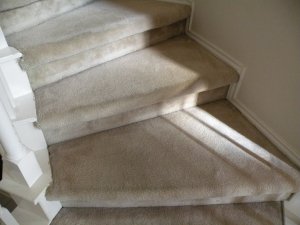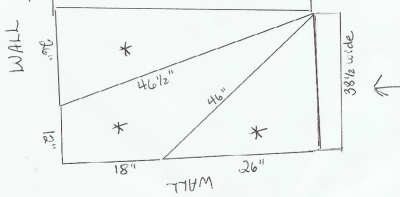Very often, we are asked "What do I do about my landing where my stairs change direction?" or "I have a curved stair case where each tread is shaped like a triangle, now what?" In this article, we will try to address some basic strategies to conquer pie steps and landings.
Prefinished stair treads offer an excellent opportunity to conquer unusual or non-standard stairs cases. With a couple of extra measurements, you can order prefinished stair tread blanks and cut your own patterns to fit your particular situation. If possible, your account manager can even put your measurements into our CAD system and see if we can yield two steps from one tread blank which helps reduce the cost.
If you have an "open rise" staircase or need thicker stair treads to install without a riser, see our thick stair tread article.
Pie Steps, Angled Stairs and Winders
Often, pie steps are utilized instead of a landing to change the direction of a staircase. This method allows the staircase to continue to rise and requires a smaller footprint than a traditional landing. Most commonly, there are three or more winding treads used to change the direction of the staircase up to 90 degrees. These treads will be wider on one side than they are on the opposite side and will probably have a "trapezoidal" shape as opposed to a true triangle.
In order to install a prefinished stair tread or retro tread to replace or cover this step, you will need to do some field fitting and cutting. What we will provide will be an oversized stair tread that is large enough for your shape to be cut.
Take a look at the following sketch:
This set of stairs has three pie steps that change the direction of the staircase 90 degrees to the right. This customer provided a sketch with the dimensions of each leading edge as well as the wall lengths. From these measurements, we can determine the size of each oversized stair tread required to completely cover the winding step.
As a rule of thumb, you want to measure the depth of the winding or pie step perpendicular to the bullnose at the tread's widest point.
From this drawing, we can overlay the stair tread shapes on a larger square oversized tread. We also must ensure that the bullnose is aligned with the existing leading edge of the step. Notice the oversized stair tread for step 1 is outlined in red and the measurements from the sketch are outlined in black.
Since we sell oversized stair treads in 6" increments, the total width is increased to 42" and not having a price change between 27" and 30", we opted for the largest tread available for the price to allow for any measurement errors. We continue with the remaining two pie steps as detailed in the below diagrams.
In conclusion, here's a summary of the final tread sizes to complete this particular project:
- Step 1: 30" x 42"
- Step 2: 30" x 60"
- Step 3: 30" x 54"
By using oversized stair treads, large winding steps and pie steps can easily be replaced. In this particular project, the customer opted for 1" solid traditional stair treads but we can just as easily make the oversized stair treads in the Retro style with a 1" bullnose and 3/4" tread body. At the time of this writing, we are only offering 3 species in oversized treads online but we can make these stair treads in any species that we offer our standard stair treads. If you need something that you are having trouble finding, please don't hesitate to [contact us].














Log In